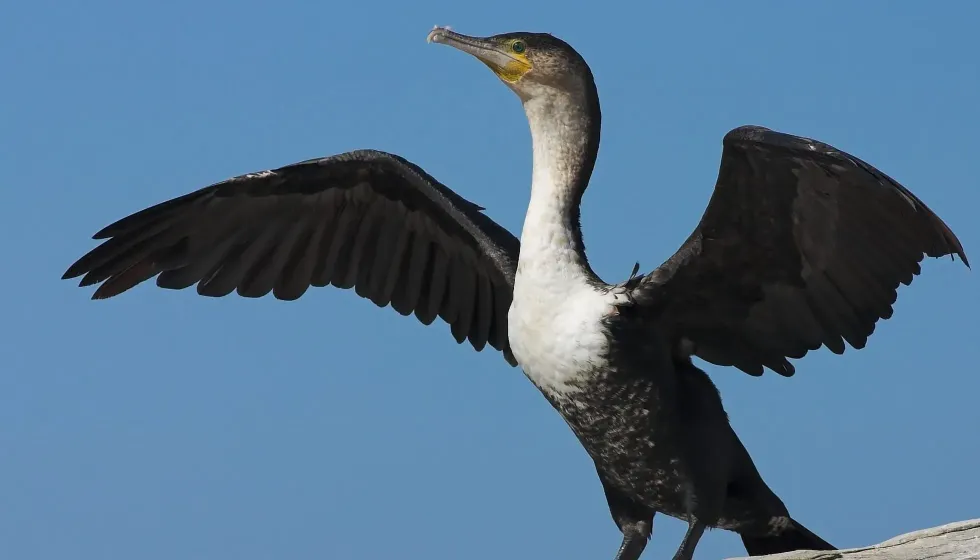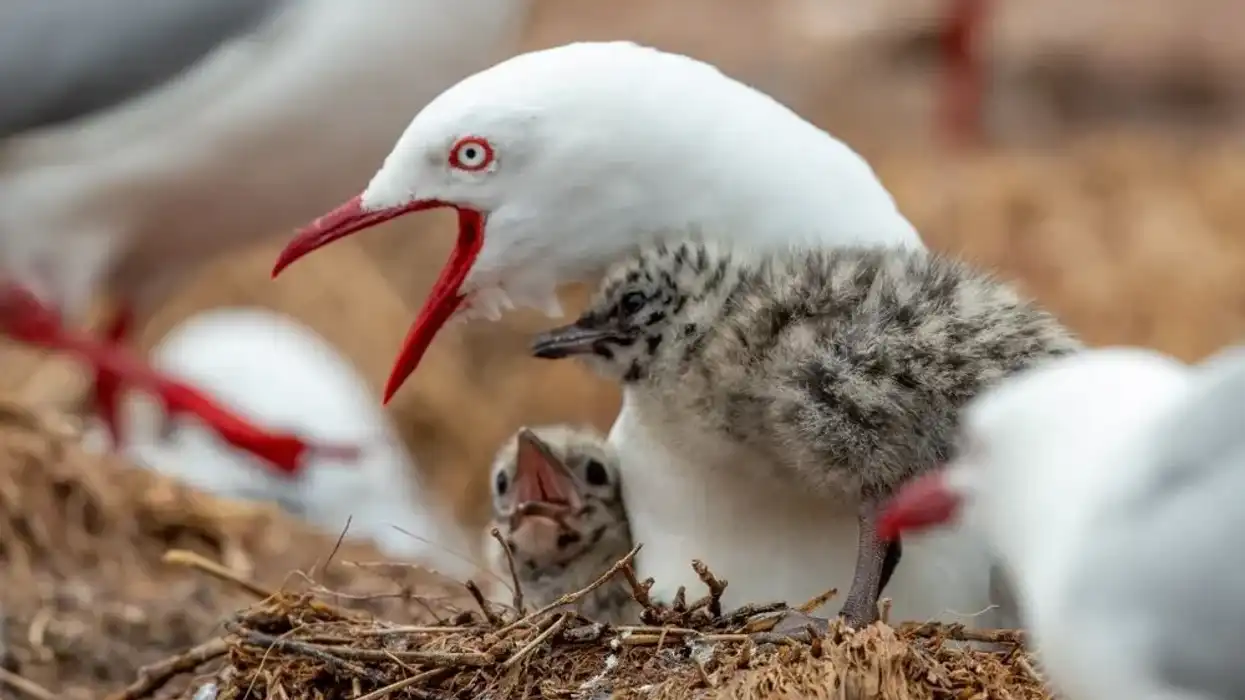How many unique ducks do you know of? Here is one of the most unique of them all!
The white-breasted cormorant is one of the rare ducks that love saline water! Popularly found in wetlands across Africa, this bird is a sight for sore eyes indeed.
They are shy towards humans but will be gregarious amongst their own species and will be frequently seen gathering around in a small group or a larger congregation in these regional wetlands.
Regional wetlands are found in Nigeria, Angola, and various other small nations in Africa. These birds also have an impressive lifespan of up to 25 years, which is positively unheard of in similar species that clock in approximately 15 years in terms of lifespan in South Africa.
These medium-sized birds may be intimidating in the description but are described as elegant and graceful when alone or in a group and can be wonderful to look at.
Read on to know more about this bird, and make sure you check out other amazing birds like the pelican and blue jay.
White-Breasted Cormorant Interesting Facts
What type of animal is a white-breasted cormorant?
The white-breasted cormorant, Phalacrocorax lucidus, is a type of duck.
What class of animal does a white-breasted cormorant belong to?
These species of cormorant (family: Phalacrocoracidae) belong to the class of birds.
How many white-breasted cormorants are there in the world?
The population of fish-eater white-breasted cormorant, Phalacrocorax lucidus, earlier subspecies of great cormorants, has yet to be counted.
Where does a white-breasted cormorant live?
This African bird, the white-breasted cormorant, lives in the wetlands. Coastal West and South Africa, from the Cape Verde Islands through Guinea-Bissau and Angola towards the Cape of Good Hope, and the North and East coast of Mozambique, are all home to these cormorants.
It can also be found in Eastern Africa's interior.
In addition, inland populations can be found in Nigeria, Sudan, and eastern and southern Africa. However, most of the time, they are seen in a group, unlike the tricolored heron, which is a similar species of cormorant and is a lonely bird.
What is a white-breasted cormorant's habitat?
Open water, especially brackish, saline, and freshwater, is preferred by the white-breasted cormorant. This fish-eater prefers shallows near the ocean's coastlines, although it can also be located inland among dams, lakes, and rivers with plenty of fish. Deltas and estuaries and mangroves, bays, and coastal lagoons are all places where they can be found.
Who do white-breasted cormorants live with?
The white-breasted cormorant, Phalacrocorax lucidus, is both gregarious and solitary, depending on the season.
How long does a white-breasted cormorant live?
In the wild, these fish-eating cormorants (family: Phalacrocoracidae) can live up to 25 years.
How do they reproduce?
The breeding season lasts all year, with the best months being September and December. The white-breasted cormorant breeds in groups of less than 50 individuals. The male white-breasted cormorant, Phalacrocorax lucidus, gathers nest materials, but the female constructs the nest. This nest is a flat platform constructed of twigs, sticks, and feathers.
The female lays three to four eggs in the nest. Both adults incubate these eggs for 28-30 days. Then, between the belly feathers and the big webbed feet, the eggs are incubated.
The chicks are born naked; however, a black down immediately grows on them. The parents regurgitate food to feed their chicks. The weakest chicks perish fast, but the strongest young can defend themselves from predators by constantly shaking their heads and lunging.
Whether it's during the non-breeding or breeding season, the great cormorant (Phalacrocorax carbo) birds like to reside in groups. During the breeding season, the colonies are larger and include a family of cormorants. The nests of Phalacrocorax carbo are reusable during mating season.
What is their conservation status?
The conservation status of this African species is marked as Least Concern, according to the IUCN Red List.
White-Breasted Cormorant Fun Facts
What do white-breasted cormorants look like?
Excluding the white patch on the thigh and the white cheeks, breast, and fore-neck, the adult cormorant has lustrous dark brown feathers. The plumage on the upper wing is extensively bordered pale buff, giving it a scaled appearance. Dark brown feathers cover the head, forehead, nape, crest, and hindneck, with scruffy feathers on the hindneck.
Females and males have a lot in common. However, outside of breeding, they have been a little duller. Adults are paler than juveniles.
Like cormorants, the anhinga birds have a small head that appears to be nothing more than a continuation of the animal's lengthy neck.
How cute are they?
Although this fish-eating bird with white breasts isn't particularly colorful, some people find its gestures and overall appearance to be adorable.
How do they communicate?
The white-breasted cormorant, Phalacrocorax lucidus, is normally silent, although it makes hisses, grunts, squeals, and growls, in colonies and around the nest.
How big is a white-breasted cormorant?
The average length of an adult cormorant who lives in Africa is about 31-39 in (80-100 cm). Birds of North America's Neotropic cormorant length measure up to 24 in (60 cm). White-breasted birds are larger than Neotropic species.
How fast can a white-breasted cormorant fly?
Although the exact flight speed of white-breasted cormorant, Phalacrocorax lucidus, is unclear, certain cormorant species can achieve speeds of up to 35 mph (55 kph).
How much does a white-breasted cormorant weigh?
The average weight of these African species white-breasted cormorants is between 5.73-8.15 lb (2.6-3.7 kg).
What are the male and female names of the species?
There is no special title for male and female species of white-breasted cormorant, Phalacrocorax lucidus, and related birds like the Phalacrocorax carbo.
What would you call a baby white-breasted cormorant?
Baby birds of this Cape island species have no distinguished name.
What do they eat?
The white-breasted cormorant birds eat crustaceans, fish, and occasionally mollusks.
Are they poisonous?
The white-breasted cormorant, Phalacrocorax lucidus, home to Southern Africa, is not a poisonous species.
Would they make a good pet?
African species of cormorants are not suitable as pets. If you've ever engaged with a sea-bird for any length of time, you're well aware that their poop stinks! It is also prohibited to keep a cormorant as a pet in most regions.
Did you know...
All-white underparts from the throat part to the bottom of the tail distinguish the great juvenile cormorant (Phalacrocorax carbo) birds. Cormorants are classified as water-birds rather than sea-birds since they are seldom seen at sea. Instead, they like the coast of a range of marine, saline, and freshwater bodies of water.
The white underparts of the white-breasted cormorant contrast sharply with dark upperparts, distinguishing it from related species P. carbo. In its African distribution, it is mostly sedentary.
Cormorants jump from the surface of the water and glide underwater using the unusual and coordinated paddling from both webbed feet while their wings remain folded up against their bodies. They move at a speed of 3.7-5.6 mph (6-9 kph) when swimming.
Cormorants eat a wide variety of fish, ranging in size from 1.18-19.68 in (3 -50 cm) in length.
What is special about white-breasted cormorants?
The white-breasted cormorant Phalacrocorax lucidus birds mostly found in Africa are the only species of great cormorant found throughout Sub-Saharan Africa, the only species with exclusively freshwater populations, and the only species with a white throat and breast; nevertheless, in central Africa, it interbreeds easily with dark-breasted variants.
Are white-breasted cormorants endangered?
Disturbance on the nesting grounds, oil pollution, fishing nets at sea, feral dogs, illnesses, and fishermen who killed the fish-eater cormorants because they are competitors are all threats to the white-breasted cormorant.
The population of the white-breasted cormorant has still not been estimated; however, it is designated as Endangered in some sections of the white-breasted cormorant range but not threatened worldwide.
Here at Kidadl, we have carefully created lots of interesting family-friendly animal facts for everyone to discover! Learn more about some other birds from our green heron facts and sanderling facts pages.
You can even occupy yourself at home by coloring in one of our White-breasted Cormorant coloring pages.









